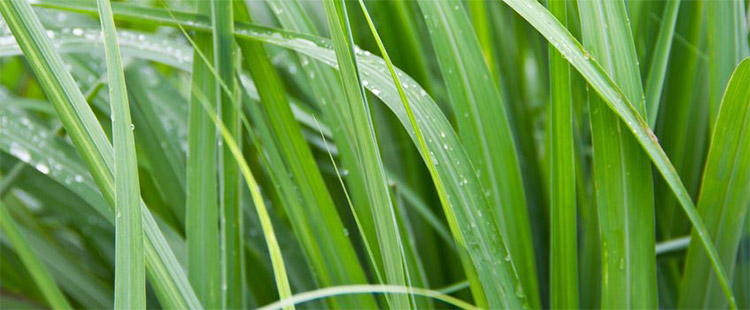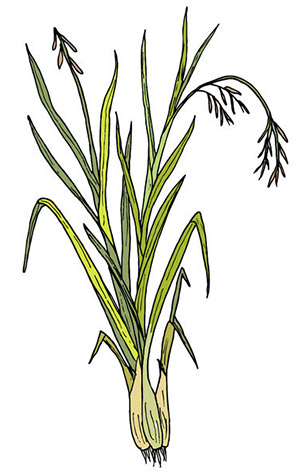Palmarosa Essential Oil
Cymbopogon martinii

Aromatically, Palmarosa Essential Oil has a slight similarity to Geranium Essential Oil and can sometimes be used as an aromatic substitute.

Description
In skin care, Palmarosa Essential Oil can be helpful for balancing dry, oily and combination skin types. A little goes a long way in skin care applications.
For emotional applications, Palmarosa Essential Oil can be helpful during times of anxiety and can be comforting and help soothe grief, emotional wounds and help diminish anger. Robbie Zeck beautifully explains that Palmarosa Essential Oil "...opens the doorway of the heart to bring love and forgiveness to traumatic events." [Robbi Zeck, ND, The Blossoming Heart: Aromatherapy for Healing and Transformation (Victoria, Australia: Aroma Tours, 2008), 102.]
In general terms, Palmarosa Essential Oil contains approximately 70-80% monoterpenes, 10-15% esters and around 5% aldehydes. It does not contain the abundance of citral (aldehyde) that Lemongrass Essential Oil and Citronella Essential Oil possesses.
As with Lemongrass and Citronella, Palmarosa is a grass that belongs to the Gramineae/Poaceae family. However, their properties and safety recommendations are different, so it's important not to assume that these three oils can be treated identically.

Palmarosa Essential Oil Benefits and Uses
- Sinusitis
- Excess Mucus
- Cystitis
- Urinary Tract Infection
- Gastrointestinal Disorders
- Scarring
- Wounds
- Acne
- Pimples
- Boils
- Fungal Infection
- General Fatigue
- Muscular Aches
- Over-excercised Muscles
- Stress
- Irritability
- Restlessness
- Insect Bites And Stings
Source: Valerie Ann Worwood, The Complete Book of Essential Oils and Aromatherapy, 25th Anniversary Edition (Novato, CA: New World Library, 2016, 611.
Botanical Name
Plant Family
Common Method of Extraction
Steam Distilled
Plant Part Typically Used
Color
Pale Yellow
Consistency
Thin
Perfumery Note
Middle
Strength of Initial Aroma
Strong
Aromatic Description
Palmarosa Essential Oil smells fresh, floral and sweet.
Major Constituents
- Geraniol
- Geranyl Acetate
- (E,Z)-Farnesol
- Linalool
- (E)-B-Ocimene
- B-Caryophyllene
- Geranial
See Essential Oil Safety for more complete list of typical constituents.
Source: B.M. Lawrence, Progress in Essential Oils. (Perfumer & Flavorist 27 no. 1, 2002), 56-57. Source cited in Robert Tisserand and Rodney Young, Essential Oil Safety (Second Edition. United Kingdom: Churchill Livingstone Elsevier, 2014), 378.
Palmarosa Essential Oil Safety Information
Tisserand and Young caution that a drug interaction may occur if using drugs metabolized by CYP2B6. They indicate that the Palmarosa Oil possesses a low risk of skin sensitization and recommend a dermal maximum of 6.5%. Reading Tisserand and Young's full profile is recommended. [Robert Tisserand and Rodney Young, Essential Oil Safety (Second Edition. United Kingdom: Churchill Livingstone Elsevier, 2014), 378-379.]
General Safety Information
Do not take any oils internally and do not apply undiluted essential oils, absolutes, CO2s or other concentrated essences onto the skin without advanced essential oil knowledge or consultation from a qualified aromatherapy practitioner. For general dilution information, read AromaWeb's Guide to Diluting Essential Oils. If you are pregnant, epileptic, have liver damage, have cancer, or have any other medical problem, use oils only under the proper guidance of a qualified aromatherapy practitioner. Use extreme caution when using oils with children and be sure to first read the recommended dilution ratios for children. Consult a qualified aromatherapy practitioner before using oils with children, the elderly, if you have medical issues or are taking medications. Before using this or any essential oil, carefully read AromaWeb's Essential Oil Safety Information page. For in-depth information on oil safety issues, read Essential Oil Safety by Robert Tisserand and Rodney Young.
Shelf Life
Important Information About the Profiles
The essential oil information provided on AromaWeb is intended for basic educational purposes only. The references to safety information, test results, constituents and percentages is generalized information. Essential oils can vary greatly in composition. The data is not necessary complete and is not guaranteed to be accurate. The essential oil photos are intended to represent the typical and approximate color of each essential oil. However, essential oil composition and color can vary based on harvesting, distillation, age of the essential oil and other factors. Profiles for several CO2 Extracts and absolutes are included within the directory, and are denoted as such.
